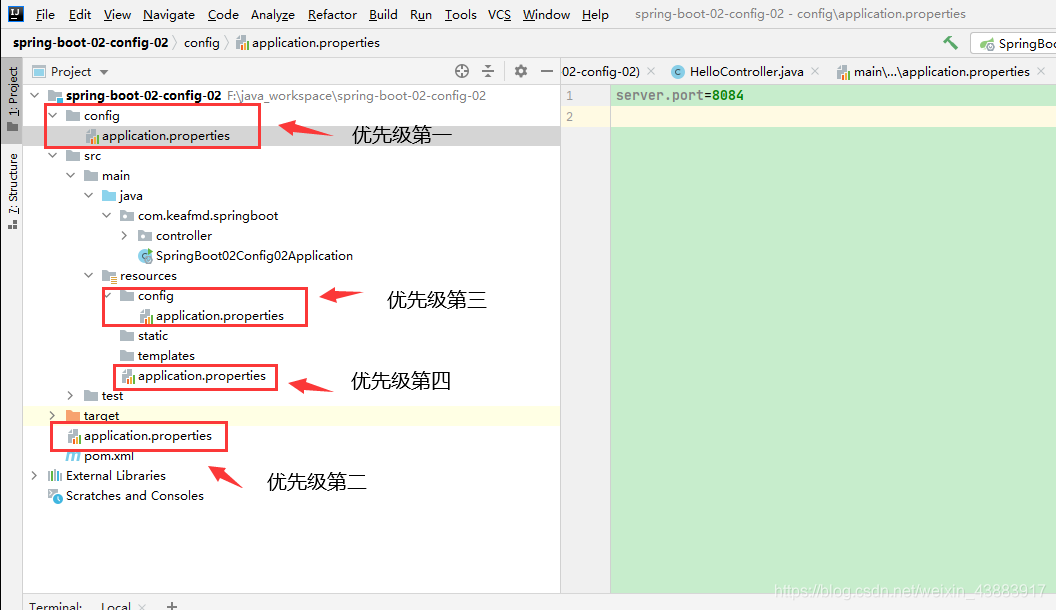SpringBoot的配置【配置文件、加载顺序、配置原理】(超详细) |
您所在的位置:网站首页 › Springboot读取配置文件的方法 › SpringBoot的配置【配置文件、加载顺序、配置原理】(超详细) |
SpringBoot的配置【配置文件、加载顺序、配置原理】(超详细)
|
SpringBoot的配置
配置文件YAML语法基本语法值的写法字面量:普通的值(数字,字符串,布尔)对象、Map(属性和值)(键值对)数组(List、Set)
配置文件值注入代码演示导入配置文件处理器,使编写配置有提示properties配置文件在idea中默认utf-8可能会乱码@Value获取值和@ConfigurationProperties获取值比较配置文件注入值数据校验@PropertySource&@ImportResource&@Bean@PropertySource:加载指定的配置文件@ImportResource:导入Spring的配置文件,让配置文件里面的内容生效,使用@Bean给容器中添加组件
配置文件占位符随机数占位符获取之前配置的值,如果没有可以是用:指定默认值
Profile多Profile文件yml支持多文档块方式激活指定profile在配置文件中指定 spring.profiles.active=dev命令行虚拟机参数
配置文件加载位置优先级由高到底,高优先级的配置会覆盖低优先级的配置SpringBoot会从这四个位置全部加载主配置文件,并且互补配置我们还可以通过spring.config.location来改变默认的配置文件位置
外部配置加载顺序
配置文件
SpringBoot使用一个全局的配置文件,配置文件名是固定的(application.properties或application.yml)。 配置文件的作用:修改SpringBoot自动配置的默认值,SpringBoot在底层都给我们自动配置好了。 以前的配置文件;大多都使用的是 xxxx.xml文件。 .yml是YAML语言的文件,以数据为中心,比json、xml等更适合作为配置文件。 配置例子: YAML: server: port: 8081XML: 8081 YAML语法 基本语法 使用缩进表示层级关系缩进时不允许使用Tab键,只允许使用空格缩进的空格数目不重要,只要相同层级的元素左侧对齐即可大小写敏感application.yml: server: port: 8081 path: /hello 值的写法YAML 支持的三种数据结构: 字面量:单个的、不可再分的值对象:键值对的集合数组:一组按次序排列的值 字面量:普通的值(数字,字符串,布尔)k: v:字面直接来写 字符串默认不用加上单引号或者双引号 “”:双引号:不会转义字符串里面的特殊字符 特殊字符会作为本身想表示的意思 name: "zhangsan \n lisi" 输出:zhangsan 换行 lisi 单引号:会转义特殊字符,特殊字符最终只是一个普通的字符串数据 name: 'zhangsan \n lisi' 输出:zhangsan \n lisi 对象、Map(属性和值)(键值对)k: v 在下一行来写对象的属性和值的关系,注意缩进和空格。 对象还是k: v的方式 friends: lastName: Keafmd age: 20行内写法: friends: {lastName: Keafmd,age: 18} 数组(List、Set)用 - 值表示数组中的一个元素。 pets: ‐ cat ‐ dog ‐ pig行内写法: pets: [cat,dog,pig] 配置文件值注入 代码演示Person: package com.keafmd.springboot.bean; import org.springframework.beans.factory.annotation.Value; import org.springframework.boot.context.properties.ConfigurationProperties; import org.springframework.context.annotation.PropertySource; import org.springframework.stereotype.Component; import org.springframework.validation.annotation.Validated; import javax.validation.constraints.Email; import java.util.Date; import java.util.List; import java.util.Map; /** * Keafmd * * @ClassName: Person * @Description: * @author: 牛哄哄的柯南 * @date: 2021-02-23 12:47 */ /** * 将配置文件中配置的每一个属性的值,映射到这个组件中 * @ConfigurationProperties :告诉SpringBoot将本类中的所有属性和配置文件相关的配置进行绑定 * prefix = "person" :配置文件中哪个属性进行一一映射 * * 只有这个组件时容器中的组件吗,才能使用容器提供的功能 */ @Component @ConfigurationProperties(prefix = "person") public class Person { private String lastName; private Integer age; private Boolean boss; private Date birthday; private Map maps; private List lists; private Dog dog; public String getLastName() { return lastName; } public void setLastName(String lastName) { this.lastName = lastName; } public Integer getAge() { return age; } public void setAge(Integer age) { this.age = age; } public Boolean getBoss() { return boss; } public void setBoss(Boolean boss) { this.boss = boss; } public Date getBirthday() { return birthday; } public void setBirthday(Date birthday) { this.birthday = birthday; } public Map getMaps() { return maps; } public void setMaps(Map maps) { this.maps = maps; } public List getLists() { return lists; } public void setLists(List lists) { this.lists = lists; } public Dog getDog() { return dog; } public void setDog(Dog dog) { this.dog = dog; } @Override public String toString() { return "Person{" + "lastName='" + lastName + '\'' + ", age=" + age + ", boss=" + boss + ", birthday=" + birthday + ", maps=" + maps + ", lists=" + lists + ", dog=" + dog + '}'; } }Dog: package com.keafmd.springboot.bean; /** * Keafmd * * @ClassName: Dog * @Description: * @author: 牛哄哄的柯南 * @date: 2021-02-23 12:50 */ public class Dog { private String name; private Integer age; public String getName() { return name; } public void setName(String name) { this.name = name; } public Integer getAge() { return age; } public void setAge(Integer age) { this.age = age; } @Override public String toString() { return "Dog{" + "name='" + name + '\'' + ", age=" + age + '}'; } }application.yml: person: lastName: Keafmd age: 18 boss: false birthday: 2020/02/02 maps: {k1: v1,k2: v2} lists: - lisi - zhaoliu - Keafmd - xiaolan dog: name: 二狗 age: 2测试代码: package com.keafmd.springboot; import com.keafmd.springboot.bean.Person; import org.junit.jupiter.api.Test; import org.springframework.beans.factory.annotation.Autowired; import org.springframework.boot.test.context.SpringBootTest; import org.springframework.context.ApplicationContext; /** * SpringBoot单元测试 * 可以再测试期间很方便的类似编码一样进行自动注入等容器 */ @SpringBootTest class SpringBoot02ConfigApplicationTests { @Autowired Person person; @Test public void contextLoads() { System.out.println(person); } }运行结果: Person{lastName='Keafmd', age=18, boss=false, birthday=Sun Feb 02 00:00:00 CST 2020, maps={k1=v1, k2=v2}, lists=[lisi, zhaoliu, Keafmd, xiaolan], dog=Dog{name='二狗', age=2}} 导入配置文件处理器,使编写配置有提示注意:我们可以在pom.xml中导入配置文件处理器,以后编写配置就有提示了。 org.springframework.boot spring-boot-configuration-processor true properties配置文件在idea中默认utf-8可能会乱码把application.yml的person注释掉,在application.properties文件中进行编写。 application.properties: # 配置person的值 person.last-name=张三 person.age=18 person.boss=false person.birthday=2022/02/02 person.maps.k1=v1 person.maps.k2=v2 person.lists=a,b,c person.dog.name=二狗 person.dog.age=3我们再次运行测试代码会发现,会出现中文乱码的情况。 解决办法: 配置文件yml还是properties他们都能获取到值 如果说,我们只是在某个业务逻辑中需要获取一下配置文件中的某项值,使用@Value 如果说,我们专门编写了一个javaBean来和配置文件进行映射,我们就直接使用@ConfigurationProperties application.properties: # 配置person的值 person.last-name=张三 person.age=18 person.boss=false person.birthday=2022/02/02 person.maps.k1=v1 person.maps.k2=v2 person.lists=a,b,c person.dog.name=二狗 person.dog.age=3Person:(部分代码,get和set以及toString不展示了) package com.keafmd.springboot.bean; import org.springframework.beans.factory.annotation.Value; import org.springframework.boot.context.properties.ConfigurationProperties; import org.springframework.context.annotation.PropertySource; import org.springframework.stereotype.Component; import org.springframework.validation.annotation.Validated; import javax.validation.constraints.Email; import java.util.Date; import java.util.List; import java.util.Map; /** * Keafmd * * @ClassName: Person * @Description: * @author: 牛哄哄的柯南 * @date: 2021-02-23 12:47 */ /** * 将配置文件中配置的每一个属性的值,映射到这个组件中 * @ConfigurationProperties :告诉SpringBoot将本类中的所有属性和配置文件相关的配置进行绑定 * prefix = "person" :配置文件中哪个属性进行一一映射 * * 只有这个组件时容器中的组件吗,才能使用容器提供的功能 */ @Component //@ConfigurationProperties(prefix = "person") public class Person { /** * * * */ @Value("${person.last-name}") private String lastName; @Value("#{11*2}") private Integer age; @Value("true") private Boolean boss; private Date birthday; private Map maps; private List lists; private Dog dog; }运行测试代码的运行结果: Person{lastName='张三', age=22, boss=true, birthday=null, maps=null, lists=null, dog=null}属性名匹配规则(Relaxed binding) – person.firstName:使用标准方式 – person.first-name:大写用- – person.first_name:大写用_ – PERSON_FIRST_NAME: • 推荐系统属性使用这种写法 配置文件注入值数据校验@Value 不支持数据校验。 需要先在pom.xml引入校验的依赖: org.springframework.boot spring-boot-starter-validationPerson:(部分代码,get和set以及toString不展示了) package com.keafmd.springboot.bean; import org.springframework.beans.factory.annotation.Value; import org.springframework.boot.context.properties.ConfigurationProperties; import org.springframework.context.annotation.PropertySource; import org.springframework.stereotype.Component; import org.springframework.validation.annotation.Validated; import javax.validation.constraints.Email; import java.util.Date; import java.util.List; import java.util.Map; /** * Keafmd * * @ClassName: Person * @Description: * @author: 牛哄哄的柯南 * @date: 2021-02-23 12:47 */ /** * 将配置文件中配置的每一个属性的值,映射到这个组件中 * @ConfigurationProperties :告诉SpringBoot将本类中的所有属性和配置文件相关的配置进行绑定 * prefix = "person" :配置文件中哪个属性进行一一映射 * * 只有这个组件时容器中的组件吗,才能使用容器提供的功能 */ @Component @ConfigurationProperties(prefix = "person") @Validated //校验 public class Person { /** * * * */ //@Value("${person.last-name}") //lastName必须是邮箱格式 @Email private String lastName; //@Value("#{11*2}") private Integer age; //@Value("true") private Boolean boss; private Date birthday; private Map maps; private List lists; private Dog dog; }运行测试类的结果: person.properties: person.last-name=Keafmd-person person.age=18 person.boss=false person.birthday=2022/02/02 person.maps.k1=v1 person.maps.k2=v2 person.lists=a,b,c person.dog.name=二狗 person.dog.age=3我们想加载这个配置文件的内容,就必须用 @PropertySource指定配置文件 package com.keafmd.springboot.bean; import org.springframework.beans.factory.annotation.Value; import org.springframework.boot.context.properties.ConfigurationProperties; import org.springframework.context.annotation.PropertySource; import org.springframework.stereotype.Component; import org.springframework.validation.annotation.Validated; import javax.validation.constraints.Email; import java.util.Date; import java.util.List; import java.util.Map; /** * Keafmd * * @ClassName: Person * @Description: * @author: 牛哄哄的柯南 * @date: 2021-02-23 12:47 */ /** * 将配置文件中配置的每一个属性的值,映射到这个组件中 * @ConfigurationProperties :告诉SpringBoot将本类中的所有属性和配置文件相关的配置进行绑定 * prefix = "person" :配置文件中哪个属性进行一一映射 * * 只有这个组件时容器中的组件吗,才能使用容器提供的功能 */ @PropertySource(value = {"classpath:person.properties"}) @Component @ConfigurationProperties(prefix = "person") //@Validated //校验 public class Person { /** * * * */ //@Value("${person.last-name}") //lastName必须是邮箱格式 //@Email private String lastName; //@Value("#{11*2}") private Integer age; //@Value("true") private Boolean boss; private Date birthday; private Map maps; private List lists; private Dog dog; }运行测试类的测试结果: Person{lastName='Keafmd-person', age=18, boss=false, birthday=Wed Feb 02 00:00:00 CST 2022, maps={k1=v1, k2=v2}, lists=[a, b, c], dog=Dog{name='二狗', age=3}}注意:需要把application.properties和application.yml里的person注释掉。 @ImportResource:导入Spring的配置文件,让配置文件里面的内容生效,使用@Bean给容器中添加组件Spring Boot里面没有Spring的配置文件,我们自己编写的配置文件,也不能自动识别。 如果想让Spring的配置文件生效,加载进来,需要把@ImportResource标注在一个配置类上。 @ImportResource(locations = {"classpath:beans.xml"}) 导入Spring的配置文件让其生效创建一个Spring的配置文件beans.xml: 创建一个helloService: package com.keafmd.springboot.service; /** * Keafmd * * @ClassName: HelloService * @Description: * @author: 牛哄哄的柯南 * @date: 2021-02-23 15:59 */ public class HelloService { }先测试下容器中有没有helloService: package com.keafmd.springboot; import com.keafmd.springboot.bean.Person; import org.junit.jupiter.api.Test; import org.springframework.beans.factory.annotation.Autowired; import org.springframework.boot.test.context.SpringBootTest; import org.springframework.context.ApplicationContext; /** * SpringBoot单元测试 * 可以再测试期间很方便的类似编码一样进行自动注入等容器 */ @SpringBootTest class SpringBoot02ConfigApplicationTests { @Autowired Person person; @Autowired ApplicationContext ioc; @Test public void testHelloService(){ Boolean b = ioc.containsBean("helloService"); System.out.println(b); } @Test public void contextLoads() { System.out.println(person); } }运行testHelloService的测试结果: false此时说明配置文件并没有生效。 我们把@ImportResource标注在主配置类上。 SpringBoot02ConfigApplication : package com.keafmd.springboot; import org.springframework.boot.SpringApplication; import org.springframework.boot.autoconfigure.SpringBootApplication; import org.springframework.context.annotation.ImportResource; @ImportResource(locations = {"classpath:beans.xml"}) @SpringBootApplication public class SpringBoot02ConfigApplication { public static void main(String[] args) { SpringApplication.run(SpringBoot02ConfigApplication.class, args); } }再次运行测试方法: true
但是在实际开发中我们会采用一种更合适的方法,SpringBoot推荐给容器中添加组件的方式是推荐使用全注解的方式。接下来把@ImportResource(locations = {"classpath:beans.xml"})注释掉,创建一个配置类MyAppConfig 。 1、创建配置类,使用 @Configuration ------>Spring配置文件 2、使用 @Bean给容器中添加组件 ==MyAppConfig: == package com.keafmd.springboot.config; import com.keafmd.springboot.service.HelloService; import org.springframework.context.annotation.Bean; import org.springframework.context.annotation.Configuration; /** * Keafmd * * @ClassName: MyAppConfig * @Description: 配置类 * @author: 牛哄哄的柯南 * @date: 2021-02-23 16:06 */ /** * @Configuration: 指明当前类是配置类,替代之前的Spring配置文件 * 在配置文件中用标签添加组件 */ @Configuration public class MyAppConfig { //将方法的返回值添加到容器中,容器中这个组件默认的id就是方法名 @Bean public HelloService helloService(){ System.out.println("配置类@Bean给容器添加组件了。。。"); return new HelloService(); } }再次运行测试方法: 我们在主配置文件编写的时候,文件名可以是 application-{profile}.properties/yml 默认使用application.properties的配置
application.properties: server.port=8081 spring.profiles.active=dev 命令行1、可以在这里配置
2、也可以直接在测试的时候,配置传入命令行参数 打包后运行jar包时,输入下面的命令: java -jar spring-boot-02-config-0.0.1-SNAPSHOT.jar --spring.profiles.active=dev 虚拟机参数 -Dspring.profiles.active=dev
springboot 启动会扫描以下位置的application.properties或者application.yml文件作为Spring boot的默认配置文件 –file:./config/ –file:./ –classpath:/config/ –classpath:/ 优先级由高到底,高优先级的配置会覆盖低优先级的配置
例子: 我们创建个HelloController: package com.keafmd.springboot.controller; import org.springframework.web.bind.annotation.RequestMapping; import org.springframework.web.bind.annotation.RestController; /** * Keafmd * * @ClassName: HelloController * @Description: * @author: 牛哄哄的柯南 * @date: 2021-02-23 17:07 */ @RestController public class HelloController { @RequestMapping("/hello") public String hello(){ return "hello"; } }这是上面优先级第四的配置文件内容: server.port=8081 # 配置项目的访问路径 server.servlet.context-path=/boot02这是上面优先级第一的配置文件内容: server.port=8084最后我们启动程序。 运行结果: 我们先在F盘放一个配置文件,在这个配置文件把端口改为8085: server.port=8085
我们先将项目打包,生成jar包。 项目打包好以后,我们可以使用命令行参数的形式,启动项目的时候来指定配置文件的新位置;指定配置文件和默认加载的这些配置文件共同起作用形成互补配置。 java -jar spring-boot-02-config-02-0.0.1-SNAPSHOT.jar --spring.config.additional-location=F:/application.properties打开便捷的控制台: 输入:java -jar spring-boot-02-config-02-0.0.1-SNAPSHOT.jar --spring.config.additional-location=F:/application.properties,然后回车:
SpringBoot也可以从以下位置加载配置,优先级从高到低,高优先级的配置覆盖低优先级的配置,所有的配置会形成互补配置 1. 命令行参数 所有的配置都可以在命令行上进行指定 java -jar spring-boot-02-config-02-0.0.1-SNAPSHOT.jar --server.port=8087 --server.servlet.context-path=/abc多个配置用空格分开, --配置项=值 运行结果: 2. 来自java:comp/env的JNDI属性 3. Java系统属性(System.getProperties()) 4. 操作系统环境变量 5. RandomValuePropertySource配置的random. * 属性值
由jar包外向jar包内进行寻找,优先加载带profile 6. jar包外部的application-{profile}.properties或application.yml(带spring.profile)配置文件 7. jar包内部的application-{profile}.properties或application.yml(带spring.profile)配置文件
再来加载不带profile 8. jar包外部的application.properties或application.yml(不带spring.profile)配置文件 9. jar包内部的application.properties或application.yml(不带spring.profile)配置文件 10. @Configuration注解类上的@PropertySource 11. 通过SpringApplication.setDefaultProperties指定的默认属性 所有支持的配置加载来源:参考官方文档 以上就是SpringBoot的配置【配置文件、加载顺序、配置原理】(超详细)的全部内容。 看完如果对你有帮助,感谢点赞支持! 如果你是电脑端的话,看到右下角的 “一键三连” 了吗,没错点它[哈哈] 加油! 共同努力! Keafmd |
【本文地址】
今日新闻 |
推荐新闻 |
 设置好再次运行测试代码 运行结果:
设置好再次运行测试代码 运行结果:










 测试一下:
测试一下:  说明这样是不起作用的。
说明这样是不起作用的。

 我们就可以发现,是启动的8085端口,证明启用的F盘的配置文件。
我们就可以发现,是启动的8085端口,证明启用的F盘的配置文件。 




